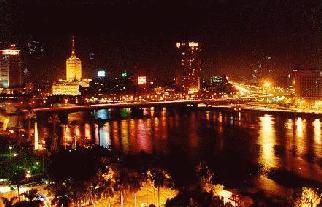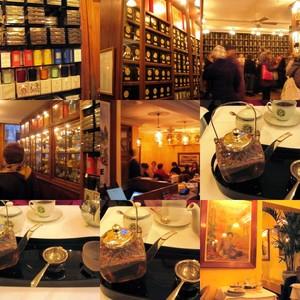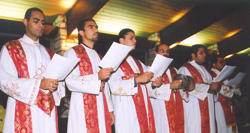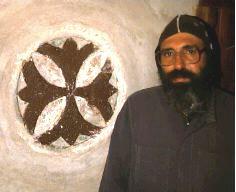
St. Peter, the Seal of Martyrs
Martyred on the Twenty-ninth Day of Hatour
+
The wave of persecution and the Coptic New Year
+
In the year 284 A.D., Diocletian became emperor and ordered the longest and fiercest persecution that Christians had ever experienced. During Diocletian’s reign, which lasted until the year 305 A.D., over 800,000 Copts were martyred. In the wake of his atrocities, Diocletian became blind and mentally deranged. Ironically, when his own people deserted him, an old Christian woman nursed him. By so doing, she obeyed our Lord Jesus Christ, who commanded us to love our enemies and bless those who persecute us.
+
To keep the memory alive of the martyrs who laid down their lives for their faith, the Coptic calendar commences with the year 284 A.D. as its starting point. The Copts follow the same calendar system of the ancient Egyptians. The Coptic year begins on September 11th and has twelve months consisting of thirty days each and a short month of five days (or six days on leap years).
+
St. Peter, the Seal of Martyrs
+
St. Peter’s father, Theodosius, was the archpriest of Alexandria. St. Peter’s mother was named Sophia. Before St. Peter was born, Sophia went to the church during the celebration of the martyrdom of the apostles St. Peter and St. Paul, on the fifth day of the Coptic month Abib. Sophia saw the other women carrying their children, and she was sorrowful. She deeply longed in her heart for a child and asked the Lord, before His holy altar, to give her a child. That night, in a vision, she saw two old men dressed in white telling her that her prayers were answered. They told her that she would be given a son who would be called Peter after the apostle, for he would be the father of a whole nation. They also commanded her to go to the Patriarch to bless her prior to St. Peter’s birth. When she woke up, she told her husband about what she had been told, and they rejoiced exceedingly. Sophia went to the Patriarch, who in turn blessed her and prayed for her coming baby.
+
In due time, St. Peter was born, as was foretold. When he was seven years old, his parents offered him to the Patriarch Abba Theonas, just like the prophet Samuel had been offered to the temple by his mother. Pope Theonas placed St. Peter in a theological school, where the saint was educated and excelled in preaching and counseling. St. Peter became like the Patriarch’s own son and was consecrated by him first as a reader, then as a deacon; then as a priest. St. Peter relieved Pope Theonas of many church administrative duties. He grew up to be learned, chaste and upright, and in due time his knowledge, wisdom and understanding earned for him the surname of “excellent doctor of the Christian religion.”
+
Shortly before Pope Theonas departed to the Lord, he advised the church leaders to choose St. Peter as his successor. Thus, St. Peter, the son of promise, became the father of a nation and the seventeenth successor of St. Mark in the year 285 A.D. When Abba Peter was enthroned on the See of St. Mark, the church was greatly enlightened by his teachings. The years in which Abba Peter guided the church were years of great tribulation for Christians. Storms raged from outside, in the form of the most terrible persecutions against Christians. Storms also raged from the inside, in the form of the Arian heresy, which was equally dangerous to the Christian faith. Like the able captain of a ship, St. Peter did his best, by the grace of God, to cope with both storms.
+
The emperor Diocletian ordered persecutions against the Christians for over ten years, which lasted day in and day out, in all forms of tortures and killings. These persecutions did not end until Abba Peter himself was martyred. Since St. Peter was the last person to lose his life for the faith under Diocletian’s reign, he is called in our church history “the Seal of the Martyrs.”
+
During the fourth year of the persecutions, Abba Peter felt it was necessary to pass special regulations concerning the acceptance of repentant apostates back into the communion of the church. He drew up fourteen canons, which came to be looked upon as a monument of church disciplines. One of the principals set in the canons was that a Christian could be baptized only once. The truth of this principle was confirmed by an incident which took place at the time.
+
A Christian woman who lived in Antioch had two sons whom she had been unable to baptize because their father had obeyed the emperor and gave up his faith in Christ in order to avoid the persecutions. Quietly, this woman boarded a ship to Alexandria and took her two sons with her. The ship had barely left the shore when a great storm arose, and the Christian woman was afraid that her sons might die without having been baptized. So, she dipped her sons in the sea three times, saying, “In the Name of the Father, the Son, and the Holy Spirit,” and then she cut her breast, and used her own blood to make the sign of the Holy Cross upon the foreheads of her two sons.
+
Eventually, the troubled sea calmed down and the ship arrived at Alexandria. On the same day, the woman took her two sons to church to have them baptized. When their turn came, and Abba Peter attempted to immerse them in the Holy Water, the water froze and became like stone. He tried three times, and the same thing happened. The Patriarch, in surprise, questioned the mother, and she told him what she had done on the way to Alexandria during the great storm. St. Peter marveled and glorified God, saying, “That is what the church proclaims, that there is only one baptism.” Therefore, the baptism that the woman performed had been accepted by the Lord.
+
Also in the days of this great Patriarch, a man named Arius was spreading heresies concerning teachings of the church. St. Peter advised Arius several times to turn from his wicked thoughts, but Arius would not listen to him. Consequently, Abba Peter excommunicated him. Arius contacted the emperor and reported to him that St. Peter, the Patriarch of Alexandria, encouraged the people not to worship the pagan gods. The emperor was outraged and sent messengers with orders to cut off St. Peter’s head. When the messengers arrived in Alexandria, they attacked the people and destroyed most of the cities of Egypt. They robbed all their valuables, and harmed the women and children. Thousands of people were killed, some with the sword, some with starvation, and some by imprisonment.
+
When Diocletian realized that after so many years of persecutions, the Christians of Egypt were not exterminated, but rather were increasing in number because of the heroism of the martyrs, he became very angry. He ordered that the religious leaders be arrested and tortured, thinking that, by torturing the leaders, he would break the spirit of the people. Six bishops were arrested, but no amount of torture would induce them to renounce their faith, and they were martyred. When Abba Peter heard of their martyrdom, he fell on his knees and offered thanks to God for having kept them steadfast until the end.
+
Finally, it was decided that it was Abba Peter’s turn. The emperor’s soldiers arrested him and brought him to prison. When the people heard about their shepherd’s arrest, they gathered in front of the prison door and wanted to save him by force and by shouting. The officer in charge of his slaying was worried that the general peace would be disrupted, so he postponed the execution till the next day. When the saint saw what had happened, he wanted to deliver himself to death for his people, because he feared what might happen to his flock. He wished to depart and be with Christ, without causing any disturbances or troubles.
+
He sent for his people and he comforted them and advised them to adhere to the true faith. When Arius, the infidel, learned that St. Peter was departing to be with the Lord, while Arius would be left in an excommunicated status, he begged St. Peter, through the high priests, to absolve him. St. Peter refused and told them that the Lord Christ had appeared to him that night in a vision, wearing a torn robe. St. Peter asked Him, “My Lord, who tore Your robe?” The Lord replied, “Arius has torn My robe, because he separated Me from My Father. Beware of accepting him.”
+
After this, the great saint signaled to the guards that he was ready to depart. St. Peter summoned the emperor's messenger in secret and advised him to dig a hole in the prison’s wall on the side where there were no Christians. The officer was amazed at the bravery of this great saint and he did as he commanded him. He took him out of prison secretly and brought him outside the city, to the tomb of St. Mark the Evangelist. There, St. Peter knelt down and asked the Lord, “Let the shedding of my blood mark the end of the worship of idols and be the end of the shedding of the blood of Christians.” A voice came from heaven and was heard by a saintly virgin who was near that place. The voice said, “Amen. May it be to you according to your wishes.”
+
The soldiers then led him to be executed. For a while, no one dared raise a hand against him, for they saw that his face was like that of an angel. Then one of the officers took out twenty-five pieces of gold and said, “I will give this gold to the one who dares behead this wise man.” The sight of gold made one of the soldiers bold enough to behead the great saint.
+
Having beheaded him, the soldiers went away, leaving him where he fell. Soon after that, the faithful children of Abba Peter heard the news and came rushing in tears. They carried away the remains of their beloved Patriarch and brought it to the church of St. Mark. They took the pure body and dressed it in the pontifical clothes and seated him on the throne of St. Mark, which St. Peter had refused to sit on during his life. He used to say that he saw the power of God sitting on that throne, and therefore, he did not dare to sit on it. The people placed St. Peter’s body with the bodies of the saints. Thus, on the twenty-ninth day of the month of Hatour, St. Peter departed to the Lord. The martyrdom of Abba Peter, that great saint who gave his life to end the wave of persecution against the Christians, inaugurated a period of peace, and that is why he is called “The Seal of Martyrs.”
+
May the prayers of this great saint, St. Peter, the Seal of Martyrs, be with us, and glory be to God forever. Amen.






